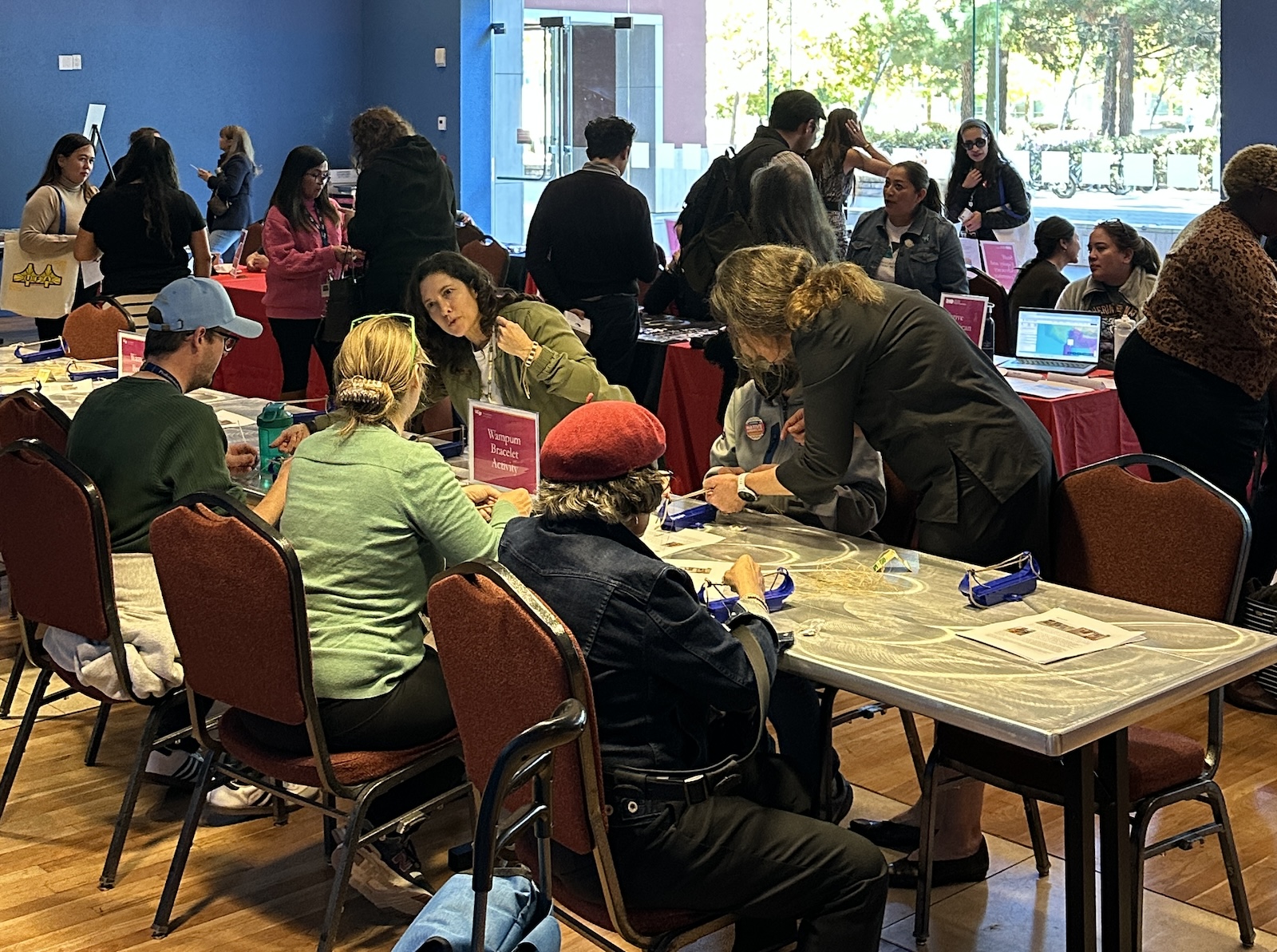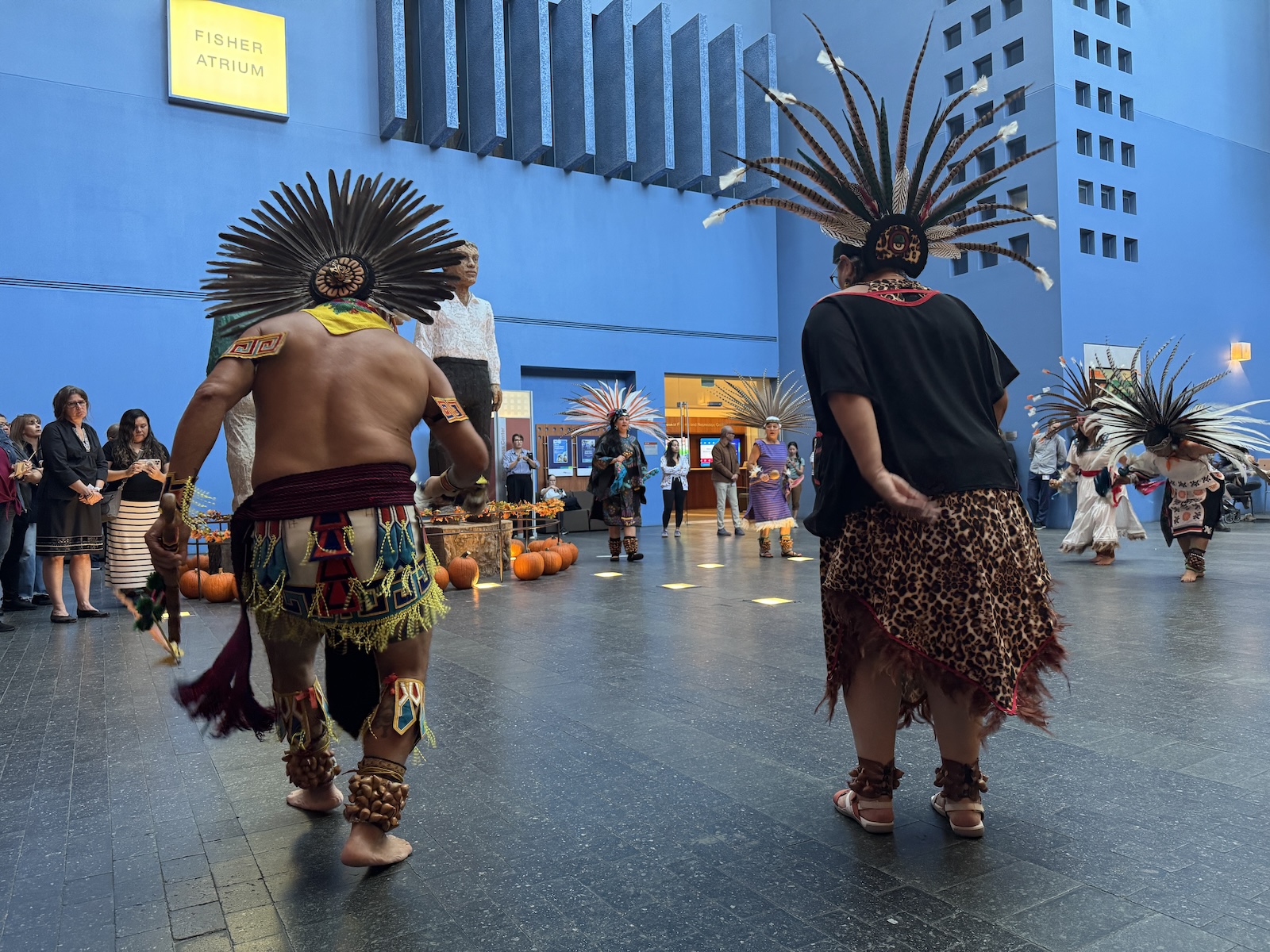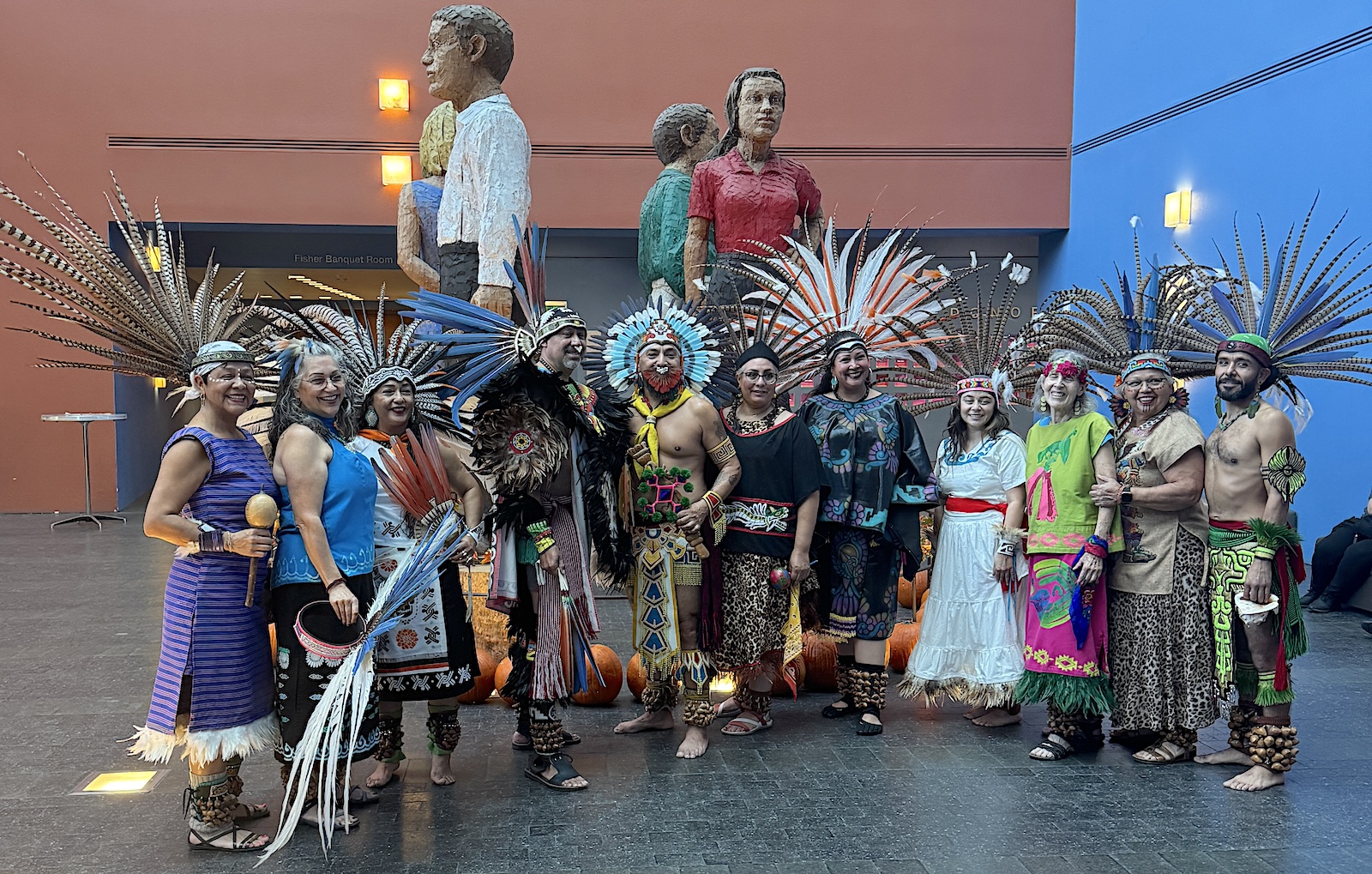Arts and Events hosted the second annual Staff Registered Campus Organization (RCO) Showcase, which highlighted Native American Heritage Month. The event was put on in collaboration with the Native American Health Alliance (NAHA), an RCO comprised of students, staff and faculty working to increase representation of Native Americans and awareness of the health disparities.
The event featured an Aztec dance showcase, a Wampum beading activity, and Staff RCO tabling and dining from Wahpepah's Kitchen, a native restaurant and food caterer based in Oakland. Monica Arellano, the Former Vice Chairwoman of the Muwekma Ohlone Tribe of the San Francisco Bay Area, gave a land acknowledgement and a blessing in her native language.
UCSF Program Manager Malinda Walker, Co-chair of NAHA and citizen of the Wyandotte nation, led the Wampum beading activity. As Walker explained to showcase participants, Wampum belts are made of purple and white beads that have been painstakingly carved from quahog (hard clam) shells. The beadwork has a significance beyond their aesthetic appeal, as they were used to record historical events, solidify treaties, or ensure safe passage when traveling through the land of other allied nations.

“They were important because there was no written language. They were a history, and the children, primarily boys, would go to class to learn how to read them, to learn how to read them, to learn the history of our people. It was serious stuff. They were used also when a treaty is signed, two belts were made, one given to each party to commemorate what happened.”
Walker also gave the opening remarks in English and her native language of Waⁿdat, which she has been learning through language classes.
“For a long time, the historians didn't understand [that] there were actually two languages [Waⁿdat and Wendat], and because we were so far east and boarding schools were so successful, our language was devastated. My tribe is working on bringing the language back.”
Walker grew up in Humboldt county, where the largest dam removal in US history recently took place this August at Klamath River. The Yurok tribe, who had been campaigning for dam removal since the 1990’s, is now working on restoring the land.
“They’re taking out invasive plants and replanting native plants, and having the salmon come back. They've spotted the first salmon swimming up the river. So, I was also a guest on someone else's land where I grew up just like we are here in San Francisco.”
For Walker, who has worked at UCSF for over 29 years, being a co-chair of NAHA has become a valued part of her UCSF experience.
“Honestly, it's the most empowering thing I've done at UCSF. In my career here, I tend to support research projects. I'm not the person who's giving talks, so to be to be asked to give talks several times, and then to have them be really well received [is meaningful].”

Associate Director at Center for Community Engagement and NAHA co-chair, Roberto Vargas, performed with Danza Xitlalli. The group, which was founded in 1981, is the oldest Aztec Dance group in San Francisco. They describe the dance as “sacred movement that weaves together the sacred elements of the four directions, songs, sacred instruments, feathers, regalia, flowers, drumming and copal to cleanse, purify, protect, and open a pathway for prayers.”
“Even after 30 years of dancing, 20 years of being with UCSF, this was my first time bringing Aztec dance to UCSF, so that's exciting for me, merging those two important parts of my world: our native traditions and the work of UCSF to deepen ties with local communities,” Vargas said.
Vargas explained that rituals performed are often dictated by the needs of the community or the family who made the request. Some of the rituals the group leads are performed for the public or commissioned for private gatherings like weddings and graduations. Other times the group shows up by request of community members to restore peace after violence has taken place.

“One of the things that's unique about our form of indigenous dance is that it's very much about the circle and the group of people moving together…it's always inspiring, and like deeply touching for me to see our children, our nieces, our nephews, our godchildren, participating because it really encourages me to know that that these traditions will be carried on by the next generation, and that's a super powerful, humbling, heartwarming feeling.”
Walker hopes that the event gave participants a better understanding of what it means to be Native American.
“It’s important for people to know we're here and to break down some preconceived notions. I think the reason that the three of us, at my age, are often embarrassed or uncomfortable saying this is part of who we are, is less [because of] racism but [the preconceived notions] like ‘you're not a real Indian’, ‘real Indians live in teepees and wear leather, right?’, or ‘there are no real Indians left’,” Walker said, “Real Indians are here all over the Bay Area, living in the modern world. It's important for me that people know that, also to broaden their perspective, that American Indians [span] the whole continent from Alaska to the tip of South America and that these borders are things that happen because of colonialism."
Events Assistant, Annika Le, was inspired by the outcome of the event and the turnout from the UCSF community.
“It was inspiring to see the UCSF Staff RCO community come together to celebrate Native American Heritage month. From the performances and speakers to the Wampum activity, every element was authentically tied to a UCSF community member. You could feel the energy in the room. This kind of cross-cultural coalition and community connection was much needed after the election that occurred a few days prior. I was grateful to plan this event and create a space for people to come together and honor an important month,” Le said.

For Vargas, he sees part of his work as fulfilling the promise of the UCSF Land Acknowledgment.
“The [UCSF] land acknowledgement includes a statement about the intention to deepen ties with local native community. And then the last bullet on the land acknowledgement is that ‘rematriation’ of land is the ultimate goal. I got really interested in the possibilities that that statement represents, and the opportunity to make it real and substantive, not just performative.”
NAHA is currently working in collaboration with support from Office of Diversity and Outreach (ODO), Office of Community and Government Relations) (CGR) and the Office of Research (OR) to deepen relationships between UCSF and local Native-American serving organizations. Vargas also urges people to consider how they might personally support native organizations.
“It's not just about us ‘imparting our great wisdom and resources on the needy people’. It's a two-way street, and yet, we are a well-resourced institution, and local native American communities are under resourced. So, there is a power imbalance. I invite us as a UCSF community, to really consider: what are the ways that we can give an offering in this exchange?”
To learn more about the Native American Health Alliance, reach out to co-chair Malinda Walker at malinda.walker@ucsf.edu. You can also access NAHA’s list of recommended books and media here. To learn more about Danza Xitlalli you can visit their website or see them lead a ceremony for Mother Earth at the Cultura y Arte Nativa de las Americas’ (CANA) center on December 12, 6-9pm.